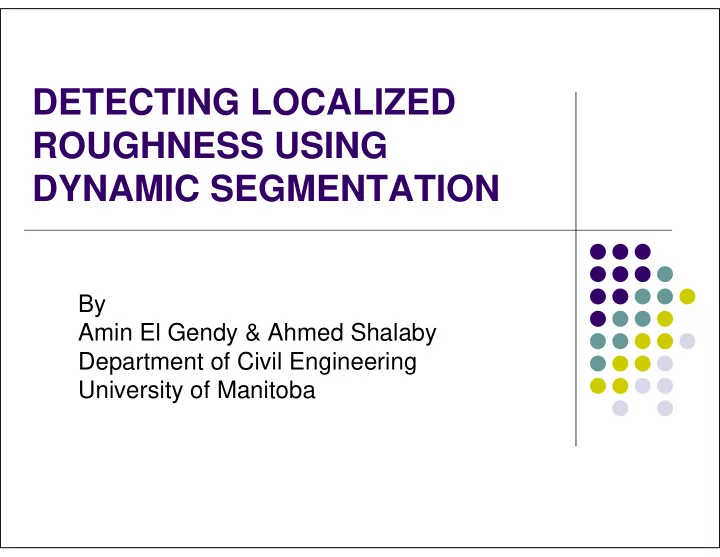

DETECTING LOCALIZED ROUGHNESS USING DYNAMIC SEGMENTATION By Amin El Gendy & Ahmed Shalaby Department of Civil Engineering University of Manitoba
The C-LTPP project The C-LTPP Project includes 24 test sites constructed between 1989 and 1991. � Each site has 2 to 4 adjacent test sections for a total of 65 test sections. � Location and identification of C-SHRP LTPP test sites.
C-LTPP profile data Profile measurements taken manually with a dipstick on annual basis. � Dipstick foot spacing is 300 mm for most of the sections. � The survey closure error was redistributed over all the measurements � recorded. IWP IWP-OWP OWP-IWP OWP Start Point 5*30 m Schematic for the dipstick profiling process
Objectives � To develop guidelines for analyzing the measurement of longitudinal pavement profile using two dynamic segmentation methods; � To demonstrate the benefits of refining the monitoring of pavement conditions; and � To Propose a model for estimating the required interval for reporting roughness profiles.
Roughness Profile 5 Max. IRI=3.82 4 Roughness Profile IRI [m/km] 3 Average IRI=2.45 2 IRI Range Min. IRI=1.36 1 0 0 20 40 60 80 100 120 140 Station [m] The roughness profile for the OWP of the test site 810404 (prior to overlay 09/06/1990)
Significance of Roughness Profile Segmentation 12 out of 1332 profiles have an IRI range smaller than 1.0mm/m. 0.2 Percentage of Frequency 0.15 0.1 0.05 0 0 0.5 1 1.5 2 2.5 3 3.5 4 4.5 5 IRI range [m/km] The frequency distribution of IRI range (1332 section profiles)
The cumulative difference approach (CDA) Pavement Response, r i r 2 r 1 r 3 X (a) Response X 1 X 2 X 3 (a) Cumulative Area, A x A x _ A x _ Z = A − A x x x (b) Cumulative Area X X 1 X X 2 X 3 (b) Cumulative Difference, Z x + Border (-) (+) X (c) Cumulative Differences X 1 (-) X 2 X 3 - Border (c) The cumulative difference approach
The absolute difference approach (ADA) Response range Average response Segment length Z r r = − r d i i d r i x i x d X The absolute difference approach
Illustrative Example Pavement Response, r i ADA Segments r 2 Pavement response Response range r 1 r 3 (a) ADA Segmentation Segment Length Pavement Response, r i r 2 CDA Segments Pavement response r 1 r 3 (b) CDA Segmentation Segment Length Cumulative Area, A x (c) Cumulative Area Cumulative Difference, Z x Segment Length + Border (+) (-) (d) Cumulative Differences (-) Segment Length - Border Segmentation Example
Combining Segments Each two adjacent segments will be combined into one segment if the difference between the maximum and minimum does not exceed the target range according to the following: 1 2 r r r for all x , x − ≤ i j Range i j Where; 1 r is the response r i at x i for segment 1. i 2 is the response r j at x j for segment 2. r j x i is any distance within segment 1. x j is any distance within segment 2. r range is the specified target response range
Statistical Comparison TABLE 1 General Statistical Summary for Segment Lengths (m), CDA Approach IRI Range Statistic (m/km) 0.2 0.3 0.4 0.5 0.6 0.7 Mean of segment lengths 7.01 11.01 14.39 16.73 18.17 18.90 Standard Error 0.06 0.13 0.20 0.25 0.28 0.30 Standard Deviation 9.60 16.47 21.87 25.47 27.58 28.90 Sample Variance 92.22 271.26 478.43 648.83 760.57 835.52 Count 24466 15819 12180 10505 9684 9315 TABLE 2 General Statistical Summary for Segment Lengths (m), ADA Approach IRI Range Statistic (m/km) 0.2 0.3 0.4 0.5 0.6 0.7 Mean of segment lengths 4.91 8.22 11.09 13.04 13.93 14.12 Standard Error 0.04 0.10 0.16 0.21 0.23 0.24 Standard Deviation 8.01 14.35 19.93 23.93 25.86 26.69 Sample Variance 64.09 205.95 397.18 572.67 668.95 712.56 Count 34328 21001 15705 13414 12568 12404
Segmented Profiles 1.4 1.2 IRI [m/km] 1 0.8 Roughness Profile CDA Segmentation ADA Segmentation 0.6 27 32 37 42 47 Station [m] The roughness profile corresponded with segmentation data for test site 810404
Relationship between segment length and IRI range 20 Average of Segment lengths [m] 16 12 8 CDA segmentation 4 ADA segmentation 0 0 0.1 0.2 0.3 0.4 0.5 0.6 0.7 0.8 IRI range [m/km] Relationship between segment length and IRI range
Reporting Interval Model 20 Reporting interval [m] 16 12 Average of CDA and ADA Logarithmic 8 Linear Quadratic 4 0 0.1 0.2 0.3 0.4 0.5 0.6 0.7 0.8 IRI range [m/km] Comparison of three models for reporting interval. TABLE 3 Models for Correlating IRI Range (m/km) and Reporting Interval (m) R 2 Model Equation SE Linear L= 21.2 IRI range + 3.1 0.92 1.29 Logarithmic L= 8.8 log e (IRI range ) + 20.4 0.98 0.54 Quadratic L= -42.5 IRI 2 range + 59.4 IRI range - 4.3 0.99 0.09
Conclusions and Recommendations � A sample of 1332 roughness profiles has been analyzed to evaluate the effect of localization of roughness values. � Two methods for segmenting profiles were used. � ADA method is recommended when IRI range is required because CDA may provide some segments that have IRI range outside the required range.
Conclusions and Recommendations (Cont.) � Segments were combined based on different values of IRI range starting from 0.2 m/km to 0.7 m/km. � The relationship between IRI range and segment length is estimated. � A quadratic mathematical model is introduced to estimate the required interval for reporting roughness profiles.
Thank You
Recommend
More recommend